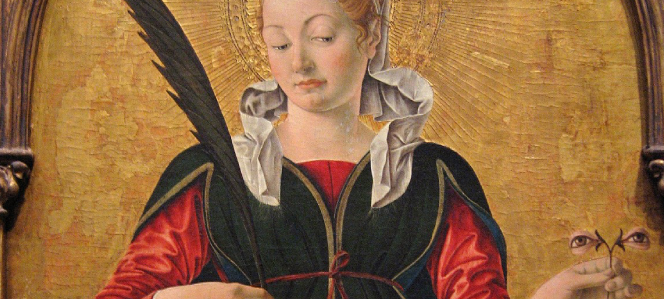Today the Church remembers and recalls the witness of a 4th century martyr whose name is Lucy.
Lucy was killed during the persecution of the Church that was orchestrated by the Roman Emperor Diocletian. Diocletian understood very well that the Church, now well established throughout the Roman Empire, was presenting an attractive and credible alternative to the culture of the Roman power. If persuasion and legal sanctions would not undermine the influence of the Church, then violence was the best strategy.
The story of Lucy’s life and death was very popular during the Middle Ages and devotion to the saint spread throughout what was then the Catholic world. Vestiges of the popularity of cult linger to this day, even in Protestant and secular countries, where customs associated with the saint are still treasured.
The story of her martyrdom emphasizes that it was her refusal to marry and her decision to remain a virgin dedicated to Christ that would be the occasion for her arrest and her execution. That she was also a member of the upper classes of Roman society did not help to keep her from harm, as Diocletian was particularly focused in his persecution of the Church at the Christians of the upper classes, whom he believed provided not only funding and protection for the Church, but also were giving the Christian Faith legitimacy in the eyes of the people.
Lucy’s insistence that she remain unmarried and dedicated to Christ was not viewed as simply a strange lifestyle choice, but an act of defiance against the values of the Roman Empire and the way of life that the Empire deemed appropriate for a woman of Lucy’s social standing.
She would pay for her defiance with her life.
We see in Lucy’s witness the beginnings of what the Church now practices as religious life- the acceptance of celibacy as a means by which one dedicates one’s life to Christ and is freed to act on behalf of the mission of the Church.
The witness of men and women like Lucy, who gave their lives so that they might live out the demands of the Gospel in the context of a celibate commitment, represents the beginning of what would become great religious communities that have nourished and continue to nourish the Church, if not with the blood of martyrdom, but with lives dedicated to loving service.
Lucy’s name means light. She is the patron of those who suffer from diseases of the eyes, and for this reason she is often portrayed by artists as holding in her hands two eyes.
One of the customs associated with Saint Lucy is that young women, on her feast day, wear on their heads wreaths of greenery with candles. The greenery represents the crown of martyrdom and the candles symbolize the halo of the saint- a halo symbolizes the radiance of Christ’s grace that shines through and transfigures a saint.
Perhaps the risk of walking with lighted candles on one’s head might evoke the risk of discipleship itself and remind us that as we make our way out on mission our efforts must be fully conscious and intentional.
The sight of this odd display, illuminating the darkness of a wintry December, can itself be an offer of grace- indicating to the faithful, not only the endurance of the memory of Saint Lucy, but the mission of the faithful to be for a world, so darkened by the power of sin and death, agents of the Lord Jesus who is himself the Light of the World.
